Atrial Fibrillation: Common Causes, Symptoms, Treatment, And More
Oct 14, 2024 By Nancy Miller
Millions of people all around suffer from the heart disorder known as atrial fibrillation (AFib). It results in tiredness, vertigo, and dyspnea from an erratic and often fast pulse. While others may not realize they have it, it might seem frightening and uncomfortable for many. Untreated, though, AFib raises the risk of more severe medical conditions, including heart failure and stroke.
The good news is that, given the correct understanding and care, AFib is treatable. Understanding AFib is a vital first step toward safeguarding your heart health, whether your symptoms are present or you want additional information. This article will define AFib and its causes, symptoms, diagnosis, and treatment approach. Knowing helps you to take charge of your health and lower your risk of problems from this prevalent ailment.

Atrial Fibrillation And Its Types
An arrhythmia, a form of abnormal heartbeat, or atrial fibrillation (AFib), is when electrical signals usually control a consistent heartbeat, but in AFib, these signals get disordered. This results in inadequate blood pumping when the heart's top chambers (atria) tremble rather than constricting as they should.
AFib can be classified into three types:
- Occasional (Paroxysmal): Usually lasting a few minutes to many days, this kind of AFib comes and goes. It could cease on its own or call for some therapy to bring it into line.
- Persistent: Lasting more than seven days, persistent AFib often requires medication or surgery to restore normal rhythm and may not go away on its own.
- Permanent: In this kind of AFib, which is constant and cannot be restored to a normal heart rhythm, lifetime maintenance with medications or other therapies is necessary.
Causes of Atrial Fibrillation
There are several ways that atrial fibrillation (AFib) could arise. High blood pressure is one of the leading causes since it can strain the heart and disturb its rhythm. Other heart-related disorders, such as coronary artery disease or heart valve issues, can also cause AFib. Some lifestyles greatly raise the risk.
Furthermore, stress and lack of regular exercise could aggravate cardiac conditions; hence, AFib is more likely. Additionally raising the risk are other medical diseases, including thyroid problems, sleep apnea, and diabetes. Age is quite essential since AFib risk increases with age. Younger people, especially those with other risk factors, can also have AFib, however. Further influencing the probability of acquiring this disorder are family history and genes. Knowing these factors will help one more successfully prevent and control AFib.
Symptoms of Atrial Fibrillation
Though some may not feel anything at all, persons with atrial fibrillation (AFib) may have several symptoms. Typical indications are:
- Palpitations: Often causing discomfort or anxiety, a sense of a racing or fluttering heart feels as though the heart is pounding too fast, too hard, or erratically.
- Fatigue: Even after a whole night of sleep, a constant sense of tiredness or exhaustion makes it difficult to go about everyday activities or participate in physical exercise without rapidly being worn out.
- Dizziness: Particularly when standing or moving quickly, a feeling of lightheadedness or unsteadiness might cause one to lose balance or risk fainting.
- Shortness of Breath: While lying down or doing light exercise, you may have difficulty breathing throughout daily activities or even during rest, as it feels like you are not getting enough air.
- Chest Pain: To the fear of having AFib symptoms, discomfort or a sensation of tightness in the chest, which occasionally can be acute or produce pressure, can be added.

Diagnosing Atrial Fibrillation
AFib diagnosis calls for multiple steps. Your doctor will start by looking over your medical background. They'll probe your risk factors and symptoms. Your heart will be evaluated on a physical exam. Your doctor might order testing to verify AFib. The most often utilized test is an electrocardiogram (ECG). It records your heart's electrical activity. Other testing could be:
- Holter Monitor: Wearing a small gadget worn 24 to 48 hours, Holter Monitor tracks cardiac activity.
- Echocardiogram: An echocardiogram is a structural and functional ultrasound of the heart.
- Blood Tests: To look for disorders like thyroid problems that might aggravate AFib.
Once diagnosed, your doctor can suggest a course of action.
Treatment Options for Atrial Fibrillation
Treating AFib seeks to get heart rhythm back to normal and avoid consequences. Based on your situation, your doctor might recommend several therapy approaches. Among them are:
Lifestyle Changes
Changing your lifestyle for the better is vital. These could consist of:
- Healthy Diet: A healthy diet includes fruits, vegetables, entire grains, and lean proteins in balance.
- Regular Exercise: Frequent exercise helps one to maintain a good weight through physical activity.
- Quit Smoking: Giving up smoking enhances general cardiac condition.
Medications
Medication prescribed by your doctor to control AFib could be Typical forms of medication consisting of:
- Rate Control Medications: Rate control medications help slow the heart rate. Two often used examples are calcium channel blockers and beta-blockers.
- Rhythm Control Medications: Medications for rhythm control promote a normal heart rhythm. Prescriptions could call for antiarrhythmic medications like amiodarone.
- Anticoagulants: Anticoagulants lower a person's risk of stroke and blood clots. Many times, they include warfarin, dabigatran, or rivaroxaban.
Procedures
If medications fail, your doctor may advise procedures. Several typical choices are:
- Cardioversion: Cardioversion is a process wherein medications or electric shocks reestablish a normal heart rhythm.
- Catheter Ablation: A minimally invasive surgery called a catheter ablation removes tiny sections of cardiac tissue, triggering AFib.
- Pacemaker: In some circumstances, a pacemakera device implanted to help control the heartis used.
Conclusion:
In conclusion, atrial fibrillation (AFib) is a common but dangerous cardiac disorder that, left untreated, can cause significant consequences. Effectively managing the condition depends on knowing its causes, symptoms, and treatment choices. There are several approaches to regulating AFib and lowering related risks, whether through lifestyle modifications, medications, or surgeries. Monitoring the condition and modifying medication as needed depend on regular doctor visits. Staying educated and proactive will help you protect your heart health and stop the long-term effects of AFib.

Combat Anxiety and Depression Through Physical Activity

Atrial Fibrillation: Common Causes, Symptoms, Treatment, And More

Liquid Calories: What You Must Know

Kombucha: 5 Powerful Health Benefits of This Probiotic-Rich Beverage
Home Gardening Made Easy: Benalla’s Guide to Growing Your Own Produce

Meditation in Motion: Ways to Find Peace Without Sitting Still

Fitness Hacks, Recommended By Personal Trainers:

Essential Strength Training for Women Over 50

Best Lower Body Superset Workout

Understanding Pronation and Overpronation in Walking and Running

Pull-up Breathing techniques: A Guide to Proper Technique
